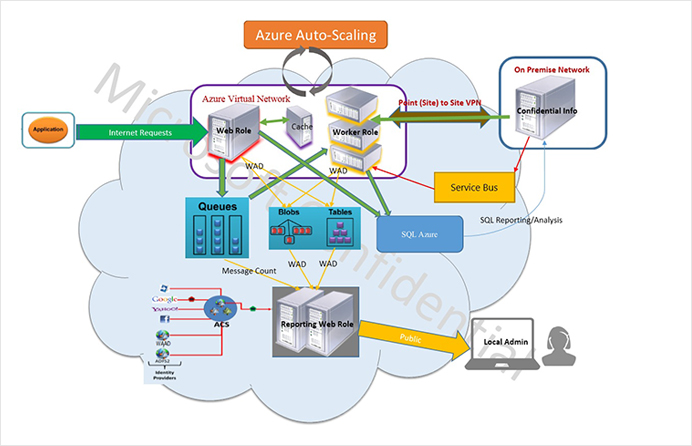One reference architecture in PaaS cloud solution.
It is from projects to demonstrate cloud energy and relieve big headaches in traditional solutions, the architecture can be realized smartly with public cloud while keep connected with local network, and the reference may help in Windows Azure, Amazon Web Service and more cloud platforms.
Highlights to demonstrate:
- Apply Microsoft cloud to grant traditional solution capability to process sudden dramatic increase requests or huge incoming traffic in a very smart way
- Able to save more than 50% system cost
- On premise solution can be integrated with or migrated to cloud services, leading to a more powerful and decoupled solution
- Numerous great features in Microsoft Azure accelerates development cycle and make online solutions easy to go with performance guarantee
- Popular 3rd party technologies can be well applied as they were
Key features involved:
- Classic programing pattern: multi tiers design & integration, security enhancement, performance optimization.
- Auto scaling on Azure: flexible cloud technology to respond changing business traffic.
- Virtual network: extend on premise network & machine to cloud, keep traditional software solution still working for Azure.
- WAD: powerful monitoring and diagnostics from Windows Azure.
- ACS: let customer benefit more from existing identity providers and Azure cloud, then focus more on business logic.
- Service Bus: solutions for those who doesn’t have public endpoint but needs real time communication.
- Cache Service: Improve performance both for Azure solution and on premise application.
- SQL Azure: Powerful Relation Database Engine on cloud, provide reliable and secure structured storage for cloud apps and local apps.
- Others: easy management and high efficiency of Windows Azure, good support on open tech and third party plugins.
Brief Workflow:
- Load test generates web requests to web role.
- Web role handles incoming traffic initially and adds the corresponding message in target storage queue.
- Worker role picks up messages from storage queue, and process them one by one.
- When worker role process a message, it needs some important information from on premise server.
- During the whole workflow, end user can trace the status of his request from web role
Reference: https://www.doingcloud.com/index.php/2016/01/29/one-reference-architecture-in-azure-paas-solution/
